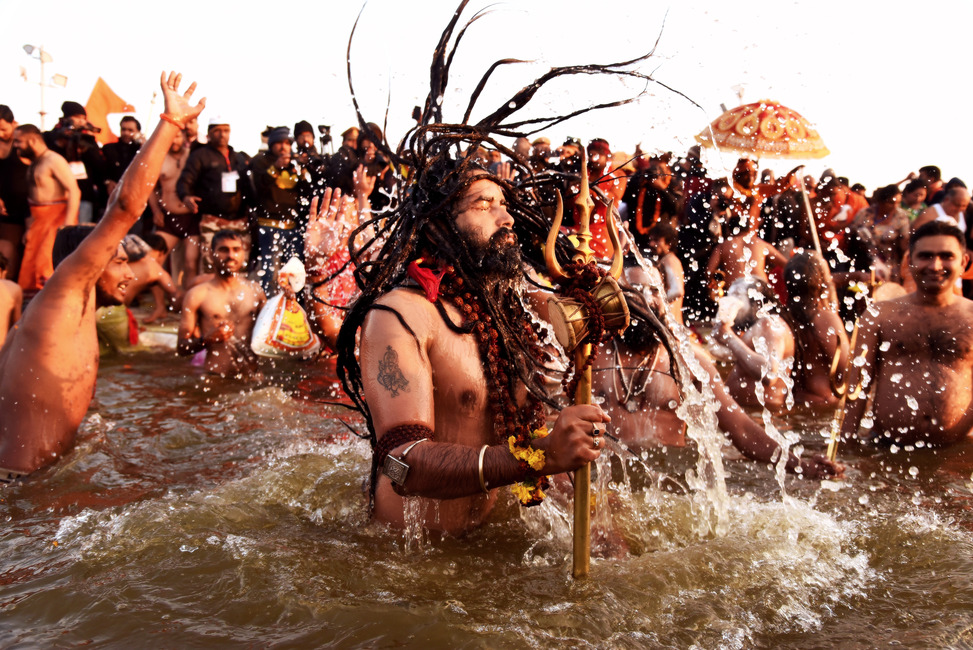
The Maha Kumbh at Prayagraj is among the grandest celebrations of humanity and has been taking place for millennia. But this edition, under Yogi Adityanath’s administration, is unlike any other in the past in every sense as it proves that ancient traditions of the Hindu faith can scaleeven greater heights in a modern world by embracing change

As far as the eye can pan, the sprawling expanse of the Sangam—the holy confluence of the Ganga, Yamuna and the
mystical and invisible Saraswati—in
Prayagraj has transformed into a city of tents and pavilions, heralding the imminent start of the Maha Kumbh: the grandest congregation of spiritual and temporal heads of the sanatan dharma (Hindu faith) and pilgrims that marks the most auspicious alignment of planets and constellations once every 12 years. This time the Maha Kumbh will be held in Prayagraj from January 13 to February 26.
The spread and scope of the Maha Kumbh, that formally rings the bell on January 13, are truly astonishing. The level of preparation indicates that the grains of sand on the riverbank at the Sangam will bear witness to something on an unprecedented scale and grandeur that will celebrate the confluence of devotion and ancient knowledge that has been passed on from generation to generation over millennia.
The arrival of eminent religious leaders, free of worldly illusions, has started.
Akhara complexes (abodes of monastic orders), richly decorated with religious
motifs, flags, and dazzling fairy lights, that will house the thousands of sadhus (ascetics) representing the rich and esoteric hues of various monastic orders, and are the spiritual soul of the Maha Kumbh, have
already been set up. Dhunis (sacred fire pits) are already blazing. Naked Naga sadhus, smeared only with a coat of ash from the dhunis, indicating complete renunciation of all worldly attachments, while some are wrapped in just a single piece of saffron cloth, sit around the sacred fire, chanting hymns and offering prayers to the gods for providing salvation to the uninitiated. The hum of activity, as finishing touches are given to the Kumbh Nagri (Kumbh City), is punctuated with collective renditions of “Har Har Gange!” (Hail Mother Ganga!) emanating from the
akharas as obeisance to the mighty river that has been the cradle of one of the greatest and oldest civilisations in the world.
The blowing of conch shells, the ringing of the bells, and kirtans and bhajans (devotional songs) wafting from the public address systems create a powerful aural medley that serves to lift the devout in a spiritual kinship over the shimmering waters at the Sangam.
It is estimated that 40-45 crore (400-
450 million) devotees will come to this
festival of spiritual awakening for 45 days
from Paush Purnima on January 13. It is more than the population of many countries such as the US, Canada, Australia, etc. It is for these reasons, and many more, that the Maha Kumbh at Prayagraj is often referred to as the ‘king of pilgrimages’.
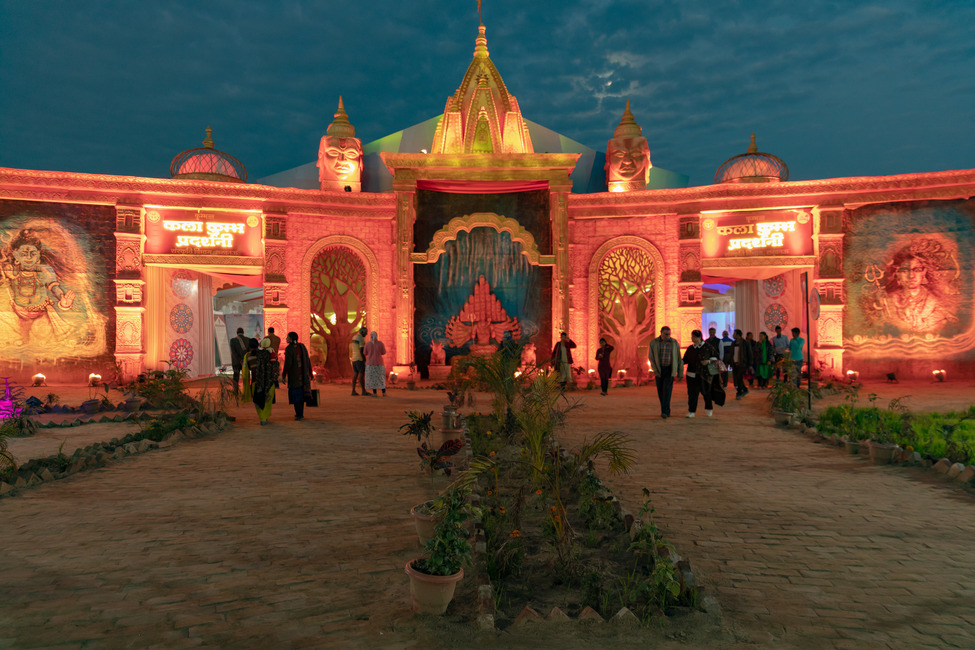


A Celestial Union And Ancient Traditions According to ancient Hindu scriptures, the Maha Kumbh at Prayagraj marks a rare
celestial phenomenon that takes place once every 12 years, when nine planets, 27 constellations and 12 zodiac signs are aligned in the same order as when the drops of holy nectar (Amrit) fell on Earth after the great churning of oceans following the contest between the devas (gods) and asuras (demons).
In the scriptures, this holy union of planets and constellations is described as: Makare ch divanathe vrusharashigate gurou. Prayaage kumbhayogau vai maghamase vidhukshaye.
In other words, when the Sun God, Bhaskar, enters the house of Capricorn and Jupiter is in Taurus, then the Kumbh takes place in the month of Magha.
This celestial alignment has been revered since the sanatan period and is marked by the Kumbh in four pilgrimage places across the country every three years.
These places are where the drops of Amrit fell on Earth—Prayagraj, Haridwar, Nashik and Ujjain. Between each Kumbh, an Ardh Kumbh (half-Kumbh) is organised in each of the four holy sites. In 2017, UNESCO
instituted the Maha Kumbh at Prayagraj in its Representative List of Intangible Cultural Heritage of Humanity as the largest peaceful gathering of people in the world.
Acharya Swami Avdheshanand Giri,
Mahamandaleshwar (spiritual head) of the Juna Akhara, says, “On the occasion of Maha Kumbh, there will be Amrit varsha (nectar shower) on the land of Prayagraj.
There is no bigger spiritual event than this nor can there be. During the Maha Kumbh, the gods in the sky perform the great churning to bless the saints on earth. This time the event will be even more divine and grand. New experiments will help in connecting the new generation with sanatan dharma.”
Over the decades, the Maha Kumbh has evolved to reflect the changing times. As such, the 2025 Maha Kumbh will be an amalgamation of spirituality with the
modernity of New India. Attempts are
being made to cast the ancient tradition of Maha Kumbh in a youthful avatar, so that it inspires youngsters to become the future flagbearers of sanatan dharma. Among all the pilgrims who come to seek spiritual salvation during the Maha Kumbh, the kalpvaasis (the permanent residents of Kumbh Nagri for the entire duration of 45 days) are among the most revered. They spend their days in meditation, studying scriptures, and offering prayers, while living a spartan and disciplined lifestyle for spiritual awakening. This year, elaborate arrangements have been made for kalpvaasis. “Maha Kumbh is an event for humanity
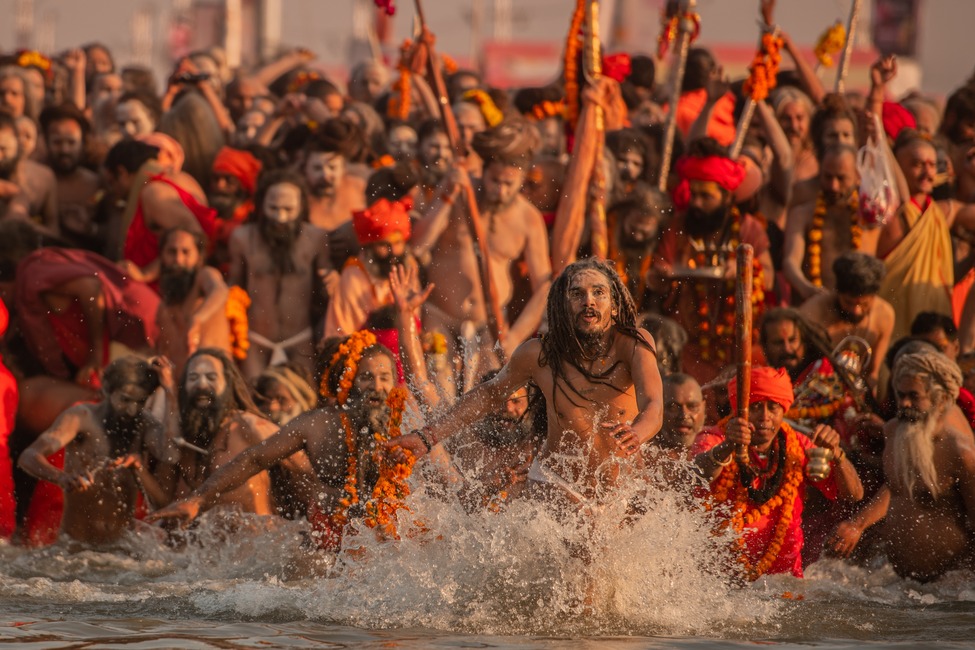
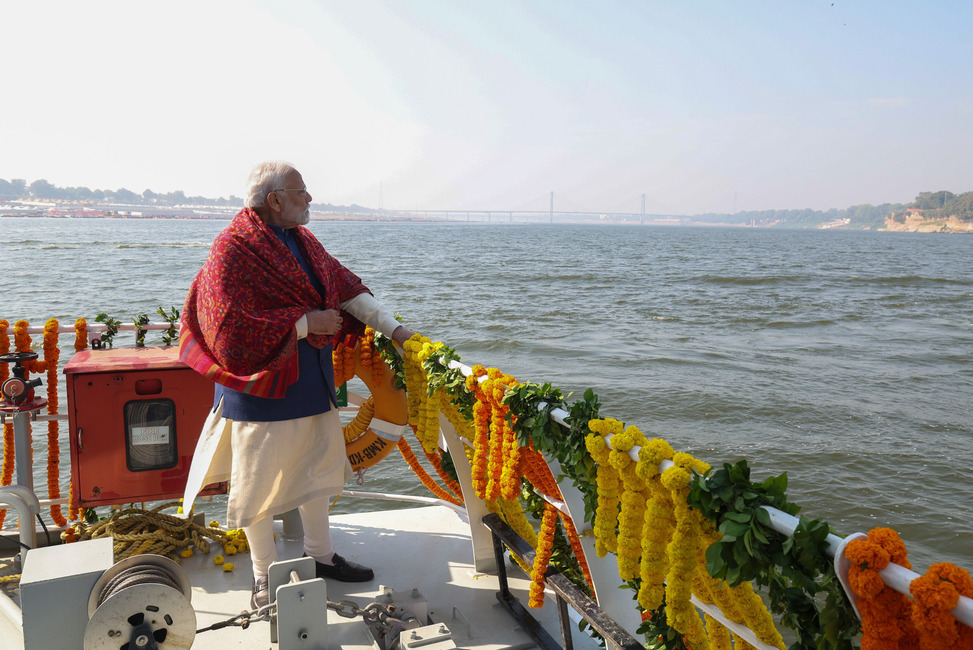
Shahi snans remain the centre of attraction at the Kumbh
On December 13, PM Modi inaugurated a slew of projects that will make the Kumbh an even more enriching experience
which helps in imbibing positive energy and spirituality and leads them in search of eternal truth,” says eminent poet and
litterateur Kumar Vishwas.
The centre of attraction of the Maha
Kumbh is the ritual of shahi snan (royal
bath) on the most important days in the
lunar calendar during the 45-day period,
when Naga sadhus of various akharas lead the bathing. The Kumbh is the only occasion when various monastic orders flowing from different spiritual traditions such as Shaivites, Vaishnavites and Shaktas come together to celebrate the festival of the shower of nectar with a ritualistic bath at the Sangam. Of the six shahi snans, the one on Mauni Amavasya (moonless night), which falls on January 29, is considered the most auspicious. This time it is expected that 6.5 crore (65 million) people will bathe at the Sangam, making it the largest congregation of pilgrims on any single day anywhere on the planet.
The spread of spiritual traditions involving the 13 akharas has become the basis for the preservation and propagation of sanatan dharma. This system of monastic order that started with the Aahwan Akhara has today reached 13 akharas over the centuries. The system of akharas was established by Adi Shankaracharya in the eighth century for propagating Hinduism across the length and breadth of the Indian sub continent, stretching from modern-day Afghanistan to Sri Lanka. Over the centuries, especially after the Islamic invasion of the sub-continent, some of the akharas transformed into militaristic orders, best symbolised by the Naga sadhus of the Juna Akhara, for the protection of the Hindu religion. The charge of the Naga religious warriors, armed with spears, swords and shields, towards the waters of the Sangam harks back to the time when men of scriptures were forced to pick up arms to ward off the invaders against the faith.
The 2025 Maha Kumbh
will be an amalgamation
of spirituality with the
modernity of New India.
Attempts are being
made to cast the ancient
tradition of Maha Kumbh
in a youthful avatar, so
that it inspires youngsters
to become the future
flagbearers of sanatan
dharma
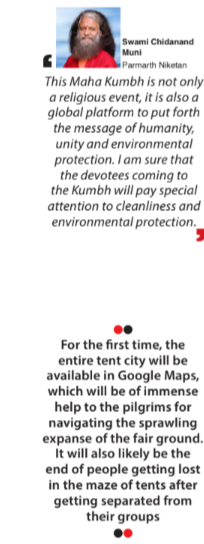
A Grand Confluence
The preparations for the Maha Kumbh indicate that technology, including AI, will be deployed on a large scale for managing the mega event. For the first time, the entire tent city will be available in Google Maps, which will be of immense help to the pilgrims for navigating the sprawling expanse of the fair ground. It will also likely be the end of people getting lost in the maze of tents after getting separated from their groups. Even some of the akharas are deploying digital technologies for people to join religious sermons remotely. It is a symbolic reflection of change that has defined the ebb and flow of civilisations since time immemorial. This Maha Kumbh will be a grand confluence of religion and spirituality, salvation, technology, and commerce like never before.
“It’s expected that this Kumbh will generate more than Rs 20,000 crore during the 45-day period,” said Rita Bahuguna, a longtime resident of Prayagraj and former BJP MP in a First Witness podcast. “Jisne Maha Kumbh nahin dekha, usne kuch nahin dekha (Someone who has not seen the Maha Kumbh has seen nothing),” she added. The UP government, under Chief Minister Yogi Adityanath, is working overtime for this Maha Kumbh, appealing to the youngsters of the country, which will strengthen sanatan dharma.
Over the centuries, the waters of the Sangam have been witness to change, defined by the rise and fall of kingdoms of
yore right up to the dawn of a modern civilisation. In continuum with this change, the city of Prayag became Allahabad before being renamed Prayagraj in October 2018 before the 2019 Ardh Kumbh. In preparation for the Maha Kumbh, this city of literature, culture and education, which has produced renowned poets, writers, intellectuals, and leaders has undergone yet another round of transformation.
Roads have been widened, new flyovers built, and prominent, historic buildings have been given a fresh coat of paint. Large scale beautification has been carried out by the UP government and Kumbh Nagri has expanded from 3,200 hectares to 4,000 hectares. It is divided into 25 zones.
Commenting on the significance of the Maha Kumbh, Prime Minister Narendra Modi said, “This Kumbh will take the cultural-spiritual identity of the country to a new height. I want to say with great faith Maha Kumbh in one sentence, I would say that it will be such a Maha yagya of unity that it will be discussed all over the world.”
To address the sustainability challenges thrown up by such mega events, the Maha
Kumbh administration is encouraging the use of plates and bowls made from leaves, kulhars (earthenware cups) and jute bags instead of plastic. Swami Chidanand Muni of Parmarth Niketan, while underlining this concern for the environment, said,
“This Maha Kumbh is not only a religious event, it is also a global platform to put
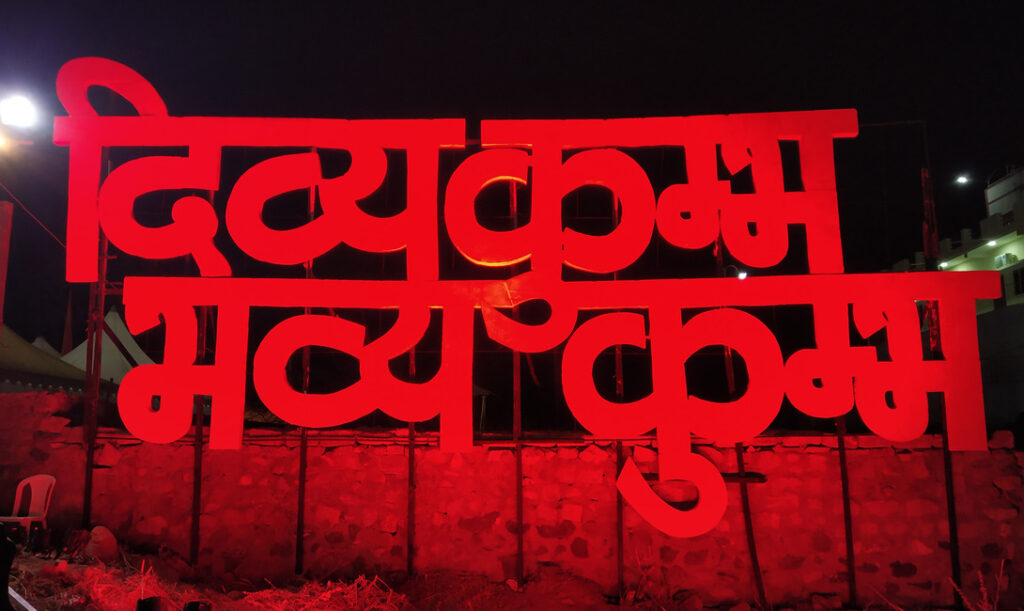

No effort is being spared to make the Kumbh more spectacular than ever before
Kumbh Nagri has expanded so much that it has been declared the 76th district of UP with a full-fledged administration
forth the message of humanity, unity and environmental protection. I am sure that the devotees coming to the Kumbh will pay special attention to cleanliness and environmental protection.”
Kumbh For Youth
There is a concerted effort to make the youth an integral part of various aspects of the grand event.
The state administration sees it as a great opportunity to connect youngsters with ancient traditions and the spirituality of
sanatan culture. “The Kumbh is an opportunity for the youth to know and
understand Indian culture closely. This is the biggest such event in the world in which crores of people come with only one purpose and that is awakening, purification and liberation. This will provide a glimpse of Indian culture, which the youth seem to be forgetting. They need to come to the Kumbh to see it,” said Alka Tomar, Arjuna Award winning wrestler.
Over the preceding months, the organisers of the Kumbh have been actively engag-
ing youngsters through various initiatives such as the Paint My City campaign for beautification of the city besides a painting competition that was organised at the historic Chandrashekhar Azad Park. The Kumbh authorities say that these measures have helped to spread awareness about one of
India’s greatest heritage icons. Vijay Kiran Anand, a senior officer who is part of the Maha Kumbh administration, says that the world will be impressed by the grandeur of the event this year.
Young people have also been roped in to help the police with crowd management and movement of pilgrims at the venue.
According to the authorities, 55 young people between the ages of 22 and 27 were recruited six months ago for carrying out a variety of tasks such as designing, data collection and analysis, and mapping the entire venue. They are being paid salaries and had to undertake a written test to qualify for various positions in the Kumbh’s administrative set-up. Since November 2022, more than 45,000 young people have undergone training and skill development for catering to the various needs of the pilgrims and tourists. Those trained include boatmen, tourist guides, street vendors and other service providers.
According to the Tourism Department of
Prayagraj, 2,000 trained boatmen and 1,000 tourist guides, 600 street vendors, and 600 taxi drivers will be deployed by the government for providing quality services to the pilgrims and tourists. This Maha Kumbh is turning out to be not only the biggest celebration of spiritualism, it is also providing employment to thousands of young people.
Over the preceding months, the organisers of the Kumbh have been actively engaging youngsters through various initiatives such as the Paint My City campaign for beautification of the city besides a painting competition that was organised at the historic Chandrashekhar
Azad Park
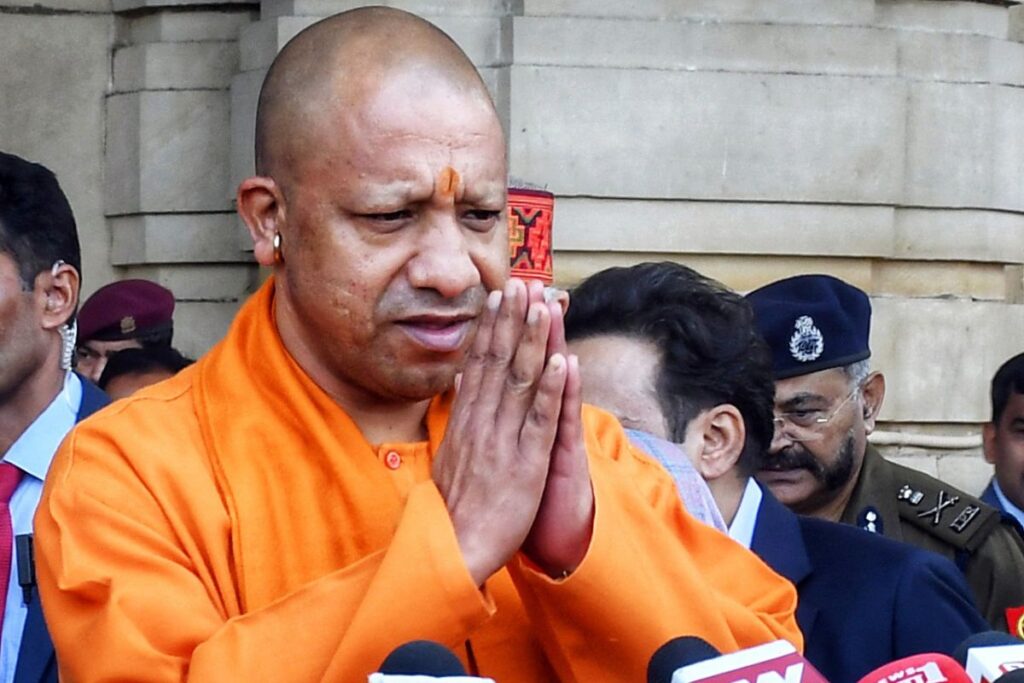
UP Chief Minister Yogi Adityanath is ensuring that the Maha Kumbh becomes the leitmotif of sanatan dharma for attracting youngsters
According to the Tourism Department of Prayagraj, 2,000 trained boatmen and 1,000 tourist guides, 600 street vendors, and 600 taxi drivers will be deployed by the government for providing quality services to the pilgrims and tourists. This Maha Kumbh is providing employment to thousands of young people
The Yogi Factor
Chief Minister Yogi Adityanath, being the
mahant (head priest) of the Gorakhnath Math, understands well the spiritual significance of the Maha Kumbh. It is also the first Maha Kumbh of his seven-year tenure as the CM of the most populous state in the country. The state government has reportedly sanctioned Rs 6,300 crore for the mega event that will be under the international spotlight as well. UP Tourism has been actively promoting the event in countries such as Thailand, Indonesia, and Mauritius.
“Earlier, the Kumbh Mela was synonymous with dirt, stampedes and chaos. The ministers in charge of the Kumbh Mela were people who had no respect for faith, tradition and heritage. But we made such arrangements in 2019 that people all over the world understood the cultural and spiritual significance of the Kumbh,” said Adityanath. The chief minister is trying to revive the mythological glory of Prayag. To uphold the spiritual purity of the Maha Kumbh, the UP government has deployed police personnel who do not consume alcohol or non-vegetarian food.
The tent city that has been set up on the riverbank at the Sangam has expanded so
much that the Maha Kumbh area has been declared the 76th district of Uttar Pradesh by the government for four months to facilitate better administration. According to Kumbh officials, it is going to be a mega logistical exercise. More than 120 parking spaces have been created that can accommodate 20 lakh vehicles while small vehicles will be pressed into service in the tent city for commuting ease of pilgrims and visitors.
More than 1,000 special trains and 7,000 buses will be pressed into service to
facilitate the travel of pilgrims from various parts of the country to Prayagraj. More than 250 special flights will operate from Kolkata, Guwahati, Delhi, Jaipur, Jabalpur, Bhubaneswar, Chandigarh and Dehradun during the 45-day period of the Maha Kumbh. It is estimated that 70 lakh to 80 lakh people will visit the Kumbh each day.
Hundreds of community kitchens are being set up by charitable organisations and NGOs that will provide free food to pilgrims, ensuring no one sleeps hungry at the Kumbh.

More than six crore people are expected to attend the Mauni Amavasya shahi snan
Where Faith Meets The Economy
The Maha Kumbh will give a major boost to the tourism economy of the state besides creating employment opportunities in different parts of the country. News reports suggest that women of 28 districts spread across Uttar Pradesh, Bihar, Madhya Pradesh, Odisha, Jharkhand, and Chhattisgarh, involving 1.25 lakh women drawn from 14,000 Self Help Groups (SHGs), are making more than 60 crore biodegradable plates and bowls that will be used at the Maha Kumbh.
According to Dr Rajni Kant, a Padma
Shri awardee for the promotion of handicrafts, the Kumbh provides an ideal
platform for showcasing indigenous art
and handicrafts to the world. “The Kumbh gives international recognition to crafts men and artisans of the surrounding districts. This is a matter of pride for India and especially Uttar Pradesh,” said Kant.
Shopkeepers who set up stalls at the
Kumbh say that things have vastly
With PM Modi personally monitoring the preparations for the festival of humanity, no effort is being spared to make the 2025 Maha Kumbh a grand success. On his visit to Prayagraj on December 13, 2024, Modi inaugurated a clutch of infrastructure and temple corridor development projects worth ₹5,500 crore
improved for them in terms of arrangements. With better facilities, more pilgrims will attend the Maha Kumbh, which will increase their incomes.
Kumbh In The Age Of Hindu Awakening
This Maha Kumbh at Prayagraj is taking
place at a time when the winds of change
are blowing in Uttar Pradesh. Just like
Prayagraj, the flag of spirituality is also
flying in Ayodhya and Kashi. After 500
years, Ram Lalla has been enshrined in the Ram Temple in Ayodhya, putting the state on the path of greatness. In January 2024, Ayodhya bathed in the light of divinity when the grand temple was consecrated by none other than Prime Minister Modi.
Similarly, the redevelopment of the Kashi corridor has freed Lord Vishwanath
from the confines of dingy lanes leading to the iconic Dashashwamedh Ghat. Now,
Mother Ganga has an unhindered view of
her beloved Lord. In the same vein, the
Maha Kumbh has provided the perfect
opportunity for the true believers of the
Hindu faith, who are currently in power, to
restore the ancient city of Prayagraj to its
original glory.
With PM Modi personally monitoring the preparations for the festival of human-
ity, no effort is being spared to make the 2025 Maha Kumbh a grand success. On his visit to Prayagraj on December 13, 2024, Modi inaugurated a clutch of infrastructure and temple corridor development projects worth Rs 5500 crore.
The temple corridors that will be developed for ease of access for pilgrims coming to Prayagraj during the Maha
Kumbh include Bhardwaj Ashram
Corridor, Shringaverpur Dham Corridor,
Akshayvat Corridor, and Hanuman
Temple Corridor. During his visit, he also
launched an AI-powered Kumbh Sahayak
(Sah’AI’yak) chatbot that will provide
comprehensive information about the
Kumbh and the city to visitors.
This being the first Maha Kumbh with
the double-engine government of the BJP,
both at the Centre and in the state, it is well on its way to showcasing the tenets of sanatan dharma in all its glory wrapped in the fabric of modernity.




Add Comment